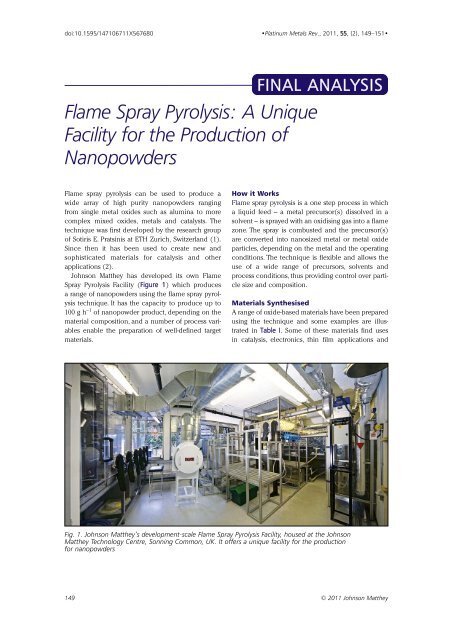Download - Platinum Metals Review
Download - Platinum Metals Review
Download - Platinum Metals Review
You also want an ePaper? Increase the reach of your titles
YUMPU automatically turns print PDFs into web optimized ePapers that Google loves.
doi:10.1595/147106711X567680<br />
•<strong>Platinum</strong> <strong>Metals</strong> Rev., 2011, 55, (2), 149–151•<br />
Flame Spray Pyrolysis: A Unique<br />
Facility for the Production of<br />
Nanopowders<br />
FINAL ANALYSIS<br />
Flame spray pyrolysis can be used to produce a<br />
wide array of high purity nanopowders ranging<br />
from single metal oxides such as alumina to more<br />
complex mixed oxides, metals and catalysts. The<br />
technique was first developed by the research group<br />
of Sotiris E. Pratsinis at ETH Zurich, Switzerland (1).<br />
Since then it has been used to create new and<br />
sophisticated materials for catalysis and other<br />
applications (2).<br />
Johnson Matthey has developed its own Flame<br />
Spray Pyrolysis Facility (Figure 1) which produces<br />
a range of nanopowders using the flame spray pyrolysis<br />
technique. It has the capacity to produce up to<br />
100 g h −1 of nanopowder product, depending on the<br />
material composition, and a number of process variables<br />
enable the preparation of well-defined target<br />
materials.<br />
How it Works<br />
Flame spray pyrolysis is a one step process in which<br />
a liquid feed – a metal precursor(s) dissolved in a<br />
solvent – is sprayed with an oxidising gas into a flame<br />
zone. The spray is combusted and the precursor(s)<br />
are converted into nanosized metal or metal oxide<br />
particles, depending on the metal and the operating<br />
conditions. The technique is flexible and allows the<br />
use of a wide range of precursors, solvents and<br />
process conditions, thus providing control over particle<br />
size and composition.<br />
Materials Synthesised<br />
A range of oxide-based materials have been prepared<br />
using the technique and some examples are illustrated<br />
in Table I. Some of these materials find uses<br />
in catalysis, electronics, thin film applications and<br />
Fig. 1. Johnson Matthey’s development-scale Flame Spray Pyrolysis Facility, housed at the Johnson<br />
Matthey Technology Centre, Sonning Common, UK. It offers a unique facility for the production<br />
for nanopowders<br />
149 © 2011 Johnson Matthey
















